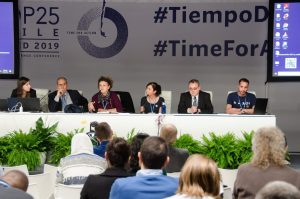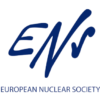COP25 Madrid – it is not any longer about climate change, but about climate emergency
The nuclear industry took part in the UN climate talks this week at a time when the subject is no longer merely climate change, but climate emergency. At a side-event organised by Nuclear for Climate, panelists described how nuclear power is an essential part of the global response to that emergency.
 The panelists in the session, titled, No time to lose – why the world needs all low-carbon energy sources to achieve its climate goals – were Valérie Faudon, co-founder of Nuclear for Climate and vice-president of the European Nuclear Society (ENS), Ignacio Araluce, president of the Spanish Nuclear Industry Forum, Jadwiga Najder, vice-chair of the ENS Young Generation Network, and Sebastien Richet, chair of the Global Initiative to Save Our Climate (GISOC).
The panelists in the session, titled, No time to lose – why the world needs all low-carbon energy sources to achieve its climate goals – were Valérie Faudon, co-founder of Nuclear for Climate and vice-president of the European Nuclear Society (ENS), Ignacio Araluce, president of the Spanish Nuclear Industry Forum, Jadwiga Najder, vice-chair of the ENS Young Generation Network, and Sebastien Richet, chair of the Global Initiative to Save Our Climate (GISOC).
They noted the progress the industry has made in the climate debate: The NICE Future initiative ensures that nuclear is now properly represented in the Clean Energy Ministerial; recent reports from the Intergovernmental Panel on Climate Change (IPCC), the International Energy Agency (IEA), and the World Energy Council have all highlighted nuclear power’s role in the energy transition; the International Atomic Energy Agency organised its first ever conference on climate change and the role of nuclear power, in which the IPCC, the United Nations Department of Economic and Social Affairs, the United Nations Economic Commission for Europe, and the United Nations Industrial Development Organisation, all participated; and the European Parliament recently passed a resolution stating that all technologies – including nuclear – are needed to combat climate change.
Technology mix
Faudon highlighted the report the IEA had issued in May, Nuclear power in a clean energy system, and cited its executive director, that, “Alongside renewables, energy efficiency and other innovative technologies, nuclear can make a significant contribution to achieving sustainable energy goals and enhancing energy security.” She noted that despite the increasing share of renewable energy in the global electricity mix, the use of fossil fuels was unchanged.
“Fatih Birol says we don’t have the luxury now of choosing our favourite technology. We need to use all forms of low-carbon energy,” she said.
She noted that in its special report – Global Warming of 1.5 degrees – the IPCC had also recognised nuclear energy as a low-carbon solution. “We have the proof that nuclear energy is efficient as a means of climate mitigation because we have several large countries, especially in Europe, that have managed to decarbonise their electricity system with nuclear, together with renewables and a lot of hydropower,” she said, adding that, Sweden, Switzerland and in particular France had shown that “decarbonisation can be done”. On the other hand, reactors have been closed in the USA, Germany and Japan, only to be replaced by gas or coal-fired generation.
She praised the research of Tsinghua University aimed at China phasing out its use of coal for power generation by 2050, by increasing the share of nuclear and renewable energies.
“China is the first in the world in terms of CO2 emissions but it is also the first to scale up nuclear in a very efficient and economical way,” she said.
Emergency
Araluce described his frustration at the lack of understanding that nuclear power is one of most important means of mitigating climate change.
“Is there a climate emergency or not?” he said. “We have to act now. An emergency for the planet, for humanity, requires all kinds of means to act. Nuclear and hydro, historically and today, are still contributing the most in combating CO2 emissions, so what’s the problem? ”
Noting that nuclear accounts for 40% of CO2-free generation in his country, Spain, and for 50% in Europe as a whole, he asked why nuclear is not supported in the EU Sustainable Finance Taxonomy.
“Why be confident that with renewables we will have enough battery storage because the technology is developing, but not be confident in the future of technology for the treatment of radioactive waste? Why is there confidence in one technology but not the other? We need to support all clean energy – renewables, hydro and nuclear – and not put barriers there when we are all moving in the same direction. We are in a climate emergency and we all need to work together.”
Extreme weather
Najder, a nuclear engineering consultant, described the extreme weather effects in several regions of the world.
“People are already suffering because of emissions from the past, present and in the future,” she said. “And we know what to do. We need to decarbonise the electricity sector. We need to electrify as big a part of other sectors as possible and most forecasts show that electricity demand will grow. The question is how we should produce all the electricity for that growing demand.”
She highlighted a study from the Massachusetts Institute of Technology Energy Initiative – The future of nuclear energy in a carbon-constrained world – that analyses the reasons behind a slowdown in nuclear energy growth and outlines measures that could be taken to arrest or reverse that trend, including moves to reduce the cost of building new nuclear capacity and creating a level playing field that would allow all low-carbon generation technologies to compete on their merits.
“We’re looking forward to the future and we know that the nuclear industry is ready to cooperate with renewable energy sources in a flexible way,” she said, adding that the cost, size, flexibility and modularity of small modular reactors offer an emissions reduction solution not only for electricity generation but also in other sectors, like district heating. She also noted the application of nuclear energy to address the impact of droughts caused by climate change through the use of reactor units for water desalination, for the “delivery of clean, fresh water to people in need”.
“I’m just starting my career and with my friends we will be taking over the task of decarbonising energy production. So, please, those who are responsible for this now, don’t make our task more costly.”
Limitation factor
Richet described GISOC’s research into low-carbon solutions within the context of the IPCC’s 1.5 degree and 2 degree scenarios, as well as the UN’s Sustainable Development Goals. GISOC, an international collaboration of scientists and engineers, is assisting the IPCC.
GISOC’s analysis established an ‘element limitation factor’ (ELF) as the ratio between consumption and resources out to 2050. Among the energy sources studied, the greatest ELF – more than 20 – is borne by batteries for solar and wind energy owing to the ‘element limitation’ of lithium and rare earth metals. The smallest ELF – less than 1 – is held by nuclear power with reprocessing and Gen IV reactors since there is no element limitation. Nuclear power without reprocessing and Gen IV reactors has an ELF of 2, with the element limitation being uranium.
“Our conclusion is that only the development of nuclear energy in conjunction with reprocessing and GEN IV reactors, in association with bio-energy and carbon capture and storage, the use of electric vehicles, and, to some extent, the use of other energy production modes in remote areas, has the potential to satisfy the various SDGs retained in [our] paper while addressing the climate change urgency,” he said.
Nuclear for Climate is a grassroots initiative gathering over 150 associations with the goal of educating policymakers and the public about the necessity of including nuclear energy among the carbon-free solutions to climate change. It was co-founded by the ENS, the French Nuclear Society and the American Nuclear Society in 2015, ahead of the COP21 conference in Paris.
Written by WNN https://www.world-nuclear-news.org/Articles/Nuclear-for-Climate-speaks-at-COP-25
